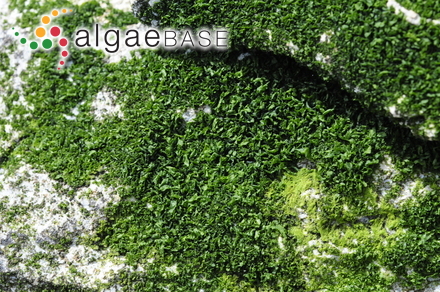Prasiola borealis M.Reed 1902

Current name:
Prasiola borealis M.Reed
Fortesque Bay, Tasmania - 31 January 2012. M.D. Guiry"
Publication Details
Prasiola borealis M.Reed 1902: 160, pl. 15: fig. 7; pl. 16
Published in: Reed, M. (1902). Two new ascomycetous fungi parasitic on marine algae. University of California Publications in Botany 1: 141-164.
Type Species
The type species (holotype) of the genus Prasiola is Prasiola crispa (Lightfoot) Kützing.
Status of Name
This name is of an entity that is currently accepted taxonomically.
Type Information
Type locality: Alaska: Unalaska and Kodiak Islands; (INA 1996) Type: W.A. Setchell; 1899; (INA 1996) Notes: Lichenized (Moniz et al. 2012).
Origin of Species Name
Adjective (Latin), north, northern (Stearn 1983).
Description
This species is characteristically infected by a fungus (Guignardia alaskana Reed), which
grows endophytically. The extent of fungal infection is largely related to the age and size
of the thallus; whereas young plants are only scarcely infected, old specimens are largely
invaded by fungal hyphae and show substantial modifications in morphology. Young
plants consist of broad blades, cuneate to obovate, arising from a short stipe attached to
the substratum by an expanded holdfast. Adult plants are 0.5-1.0 cm tall and are usually
formed by 3-4 blades arising from a common holdfast. The blades are much broader than
tall, curled and crinkled, with involute edges; not infrequently, edges of opposite sides
tend to meet and produce blades with a sac-like appearance. The color of this species is
dull olive-green; the texture of the thallus is soft and flaccid when moist, coriaceous and
brittle when dry. The blade is initially monostromatic, but in older stages it may consist
of 6-8 layers; the penetration of fungal hyphae into the thallus seems to act as an irritant
and stimulate division into multiple layers. The surface of the thallus is roughened by
numerous brownish hemispherical protrusions, 180-454 µm in diameter and 90-175 µm
high, scattered over both surfaces from near the basal parts to the apex of the blades;
these represent the perithecia, from which the reproductive bodies of the fungus are
released. In the monostromatic stages, the blade is 33-45 µm thick; the cells are clustered
in distinct tetrads (groups of 4), which are arranged in larger quadrate or polygonal areas,
with wide spaces between them. In surface view, the cells are quadrate or rectangular, 4-9
µm long and wide; in cross section they appear oblong or palisade-like, 11-14 µm high.
In older stages, a regular structure is no longer observable; the blades consist of a mixture
in which fungal hyphae completely surround and encapsulate the algal cells. At these
stages, the blades are 75-146 µm thick. No mention of specialized forms of reproduction was made in the original description. Setchell & Gardner (1920) reported aplanosporangia producing aplanospores, but without giving details.
Habitat
On rocks, just above high water mark (Setchell & Gardner 1920). It may occur in great
abundance (Reed 1902). To date reported only from Unalaska, Kodiak and Baranof Islands, Alaska (Setchell & Gardner 1920), it is no doubt more widely distributed in Alaska. Material in general agreement with the morphology of this species has been collected at Helby Island, Barkley Sound, British Columbia (Rindi & Guiry, pers. observ.).
Created: 22 March 1999 by M.D. Guiry.
Last updated: 08 December 2020
Verification of Data
Users are responsible for verifying the accuracy of information before use, as noted on the website Content page.
Taxonomic note
Saunders & Kucera (2010: 522) showed that two samples, GWS005101, Prasiola borealis and GWS005076 P. delicata, although having different morphology, had identical tufA and rbcL sequences and they hypothesize that they may belong to the same species (P. borealis having priority) and that fungal infection is responsible for the morphology observed in GWS005101. However, they note that Rindi et al. (2007, fig. 1) associated the P. borealis morph with an unidentified species in the P. crispa cluster rather than with P. delicata, suggesting that the contemporary concept of of P. borealis may include a variety of 'fungal-infected' species. An alternative explanation is that plastid introgression has occurred between the species.
- (16 April 2013) - G.M. Guiry
Distributional note
Heesch et al. (2012) record Prasiola 'borealis' from a highly nutrient-enriched habitat in a penguin colony on the Antipodes Islands. - (23 April 2012) - G.M. Guiry
Linking to this page: https://www.algaebase.org/search/species/detail/?species_id=17925
Citing AlgaeBase
Cite this record as:
M.D. Guiry in Guiry, M.D. & Guiry, G.M. 08 December 2020. AlgaeBase. World-wide electronic publication, National University of Ireland, Galway. https://www.algaebase.org; searched on 21 May 2025















